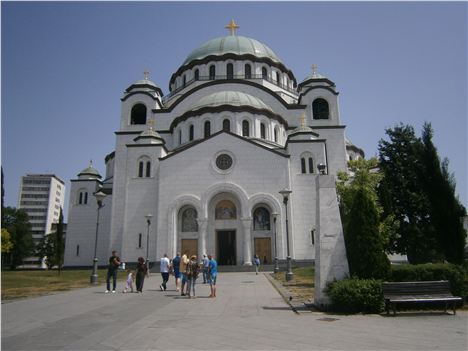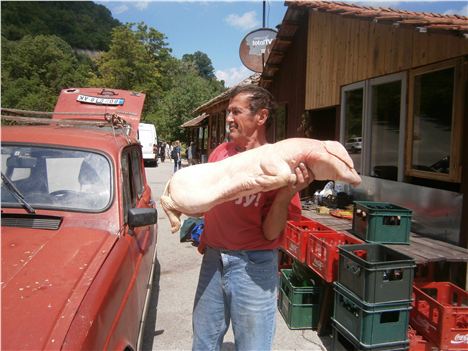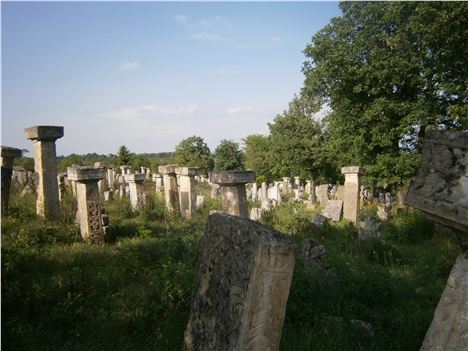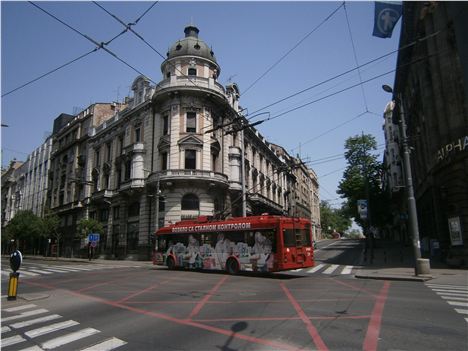THE young blond hiker was neatly packing up his camping gear on the steep slopes of the Djadap Gorge overlooking the sparkling Danube when we arrived to drink in the view of the world’s second largest gorge.
Tanned and muscular, he clambered up the grassy bank under the weight of a huge rucksack, bigger than the case I’d brought for a week travelling around Serbia.
 Jonathan Oettinger – on his daunting 3.500km charity trek
Jonathan Oettinger – on his daunting 3.500km charity trek
This was no ordinary hiker. Nineteen-year-old Slav studies undergraduate Jonathan Oettinger was walking from his home in Stuttgart to visit his girlfriend in Odessa – a daunting 3,500km journey to the Ukrainian Black Sea town where she was volunteering for a children’s charity.
What devotion. What a way to experience the countryside, the food and drink, the people and their customs, hospitality and history. His route along the Danube was taking him to Golubac, a medieval fortress on a sharp ridge at the entrance of the Derdap Gorge, which is dwarfed only by the Grand Canyon.
His journey of love was not without its scary moments. “I heard animals howling last night. I didn’t realise there were wolves here,” he grinned.
And lynx. And bears. And snakes.
He’d left Germany two months ago and, with his long, athletic strides, he reckoned he was covering 35km a day and would arrive in another month. “I am doing this for my girlfriend.”
 Felix Romuliana site is mightily impressive
Felix Romuliana site is mightily impressive
We, on the other hand, were on a different and less arduous journey of discovery, exploring ancient archaeological sites, visiting monasteries and museums, wine tasting, relishing rural cuisine, sampling the hectic nightlife of Belgrade – and even going to the opera with the Crown Prince and the President.
'The haunting atmosphere of Magura, with its dog roses and blood red peonies, was enough to induce shivers despite the heat of the midday sun'
Only the day before we met our intrepid hiker we had visited Felix Romuliana, the imperial palace of the Roman Emperor Galerius, a stunning example of court architecture dating to the 3rd and 4th centuries and 11 km from Zajecar in Eastern Serbia.
This stunning site, with its soaring columns, gates, ramparts, atriums, baths, floor mosaics and fragments of sculptures made from marble, sandstone and red and green porphyry, was placed on UNESCO’s World Cultural and Natural Heritage List in 2007.
It is the Emperor’s birthplace and he named it after his mother Romula.
On the Magura hill a kilometre east of the palace are their burial mounds and the place where they were divinised by a ceremony of apotheosis. Wax effigies of the pair were burnt so, it was believed, they would ascend into the realms of the gods.
It has been a sacred site from prehistoric to modern times, from a Bronze Age necropolis to where local villagers lit candles to commemorate their dead. The haunting atmosphere of Magura, with its dog roses and blood red peonies, was enough to induce shivers despite the heat of the midday sun.
 Barrels line up at Rajac wne village
Barrels line up at Rajac wne village
There was no better way to recover our spirits than enjoying some robust rural cuisine in Rajac, a village famed for its wine cellars. Jugs of chilled chardonnay and pinot noir were plonked on the red and white checked table cloth as our host at the rustic Sveti Trifun restaurant, Miroslav Karamancic, brought dish after earthenware dish of regional delicacies with Proja, cornbread: Belmuz, soft young unsalted soft cheese melted and mixed with corn flour; Vurda, sour cows milk, sheep cheese; powdered pork scratchings; stuffed vine leaves; beans in fried onions; pork cooked in a pot in the ashes of the fire; a dessert of walnuts in egg white and sugar.
And all the while a smiling but toothless accordion player amused us with jigs and jolly ditties, our guide Milan joining in the chorus.
No meal, it seems, is complete without a glass of Rajija, a fruit brandy flavoured with plum, apricot, quince, apple or raspberry. At up to 60 % proof the flavours are secondary to the overwhelming sensation of burning as the liquid hits your throat.
Our appetites sated we strolled through this ghost town of a village, where some of the houses at the top of the hill are let to tourists while the locals’ homes are further down. Around 1,500 of their ancestors reside on the hilltop in a cemetery where Roman remains have inspired their sandstone monuments, the bigger the gravestones indicating the wealthier the occupant.
We passed other villages where time seems to have stood still, traditional hay stacks in the fields, goats and chickens in the yard, horse-drawn carts laden with produce. By contrast, the capital of Belgrade is as bustling and modern as any European city.
Its reputation is of a restless, edgy city where young and not so young throng the 3,000 restaurants, cafes and bars and where the clubbing scene is hot and loud. But it still bears the scars of the vicious Balkan conflict when NATO bombarded targets against the regime of Slobodan Milosevic.
Belgrade, like the rest of Serbia, is in recovery from crippling inflation and unemployment, with tourism boosting the economy. It is rich in history, hospitality and architecture, where brutal Communist-era concrete eyesores vie with art nouveau and royal palaces.
By appointment you can visit the palace of Crown Prince Alexander II, a godson of Queen Elizabeth.
We timed our trip to Serbia to mingle with nobility at the Roman Arena of Viminacium, where Verdi’s opera Aida was performed by Belgrade Opera in front of an audience that included the Crown Prince, Serbia’s President and Prime Minister and foreign diplomats under a bright moon undimmed by light pollution.
 St Sava Orthodox Church, Belgrade
St Sava Orthodox Church, Belgrade
After the opening of the Constantine and His Age exhibition we nibbled canapés (not a Ferrero Rocher in sight), sipping wine and exchanging small talk with the British Ambassador Michael Davenport and his wife, who told me they’d last seen Aida in front of the Pyramids when he was Deputy Ambassador in Egypt.
On stage for this historic performance in the new amphitheatre – beside an exiting new exhibition 'Constantine and his Age,' archaeological park and scientific research centre still uncovering secrets of a Roman city that enjoyed its heyday in II Century AD – was our
guide Milan, one of the chorus. We cheered him to the heavens.
There was no sign of our intrepid hiker. He, by this time, would have pitched his tent overlooking stunning Serbian scenery on his epic journey in the course of true love. And never mind the wolves.
Fact file
Our airline was JAT Airways (www.jat.com) which flies to Belgrade from Heathrow 9 times a week; alternatively there’s Wizz (http://wizzair.com) from Luton to Belgrade 4 times a week.
Other regional airports including Manchester etc can connect via European hubs such as Paris or Frankfurt which have daily flights to Belgrade. This saves having to come to London to connect.
Regent Holidays and Travel The Unknown have good city break deals to Belgrade for as little as £349 for flights and 3 nights' accommodation, transfers and a half day city tour.
For holidays in Serbia visit:www.serbia.travel














